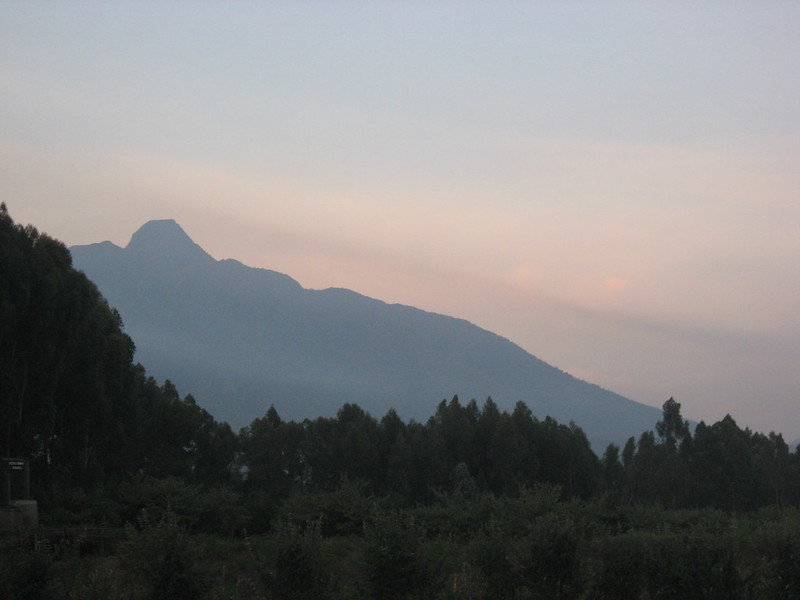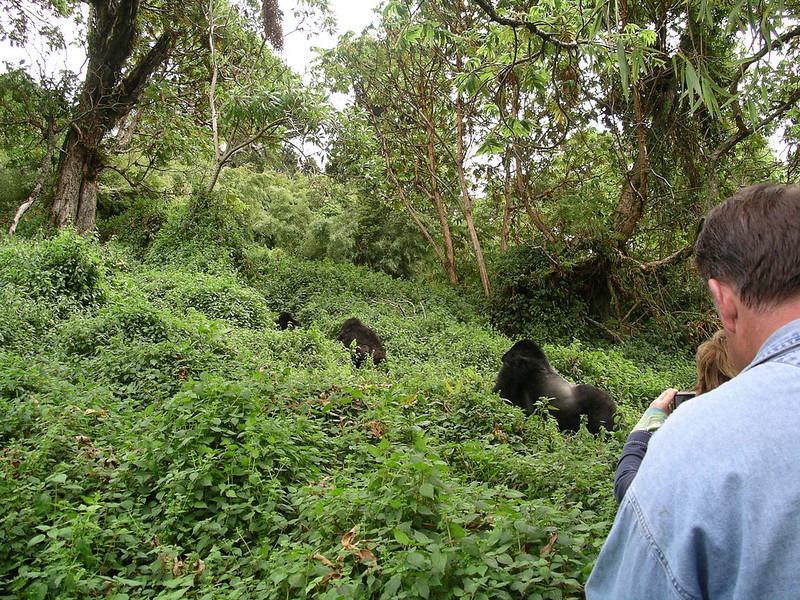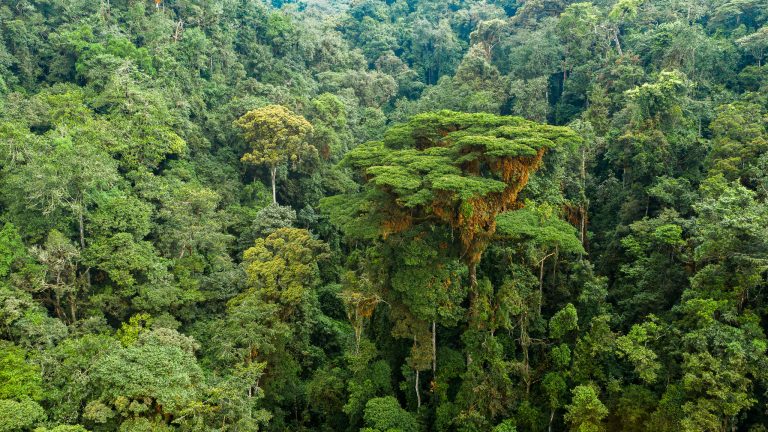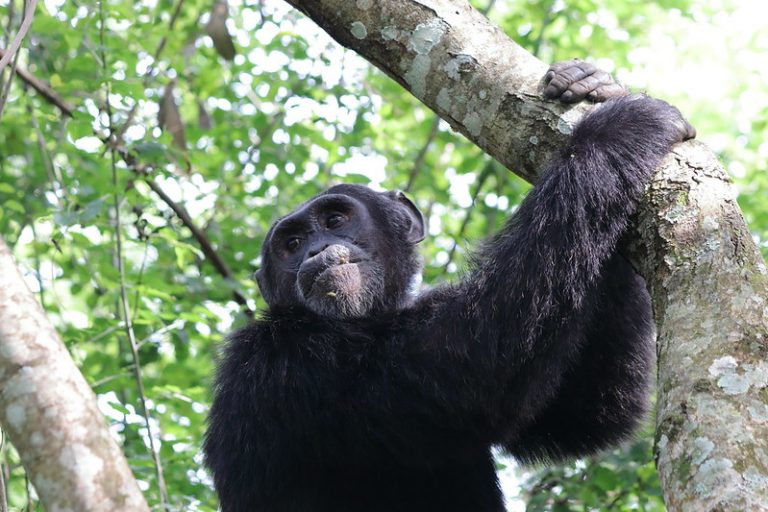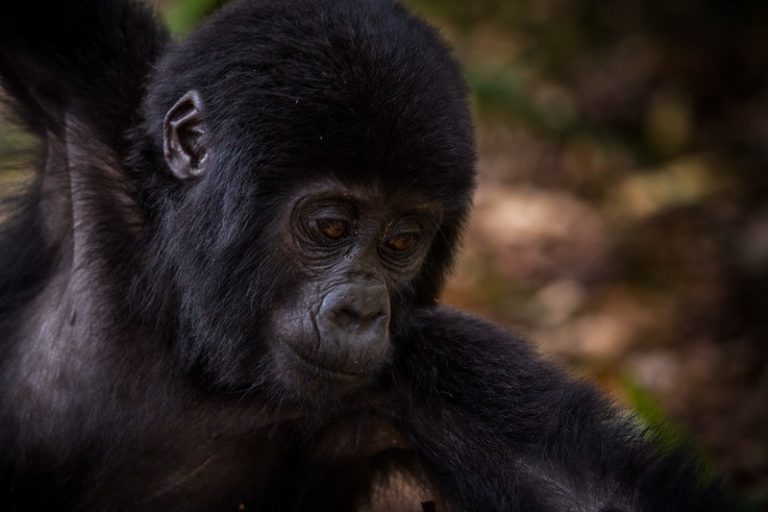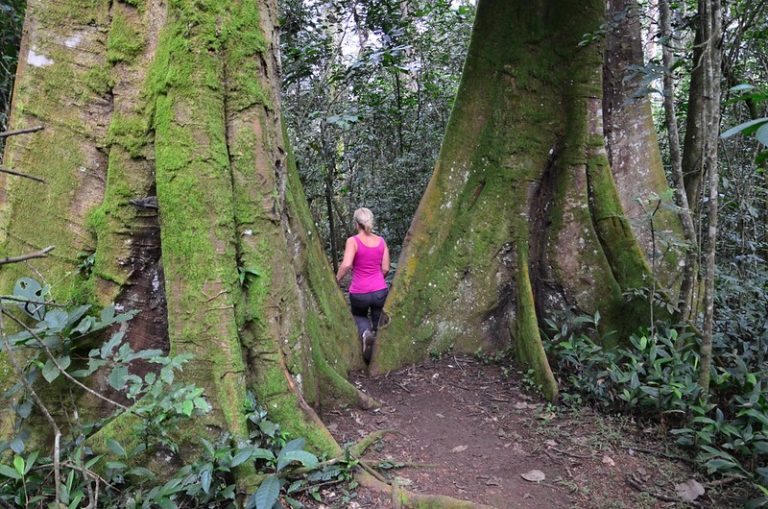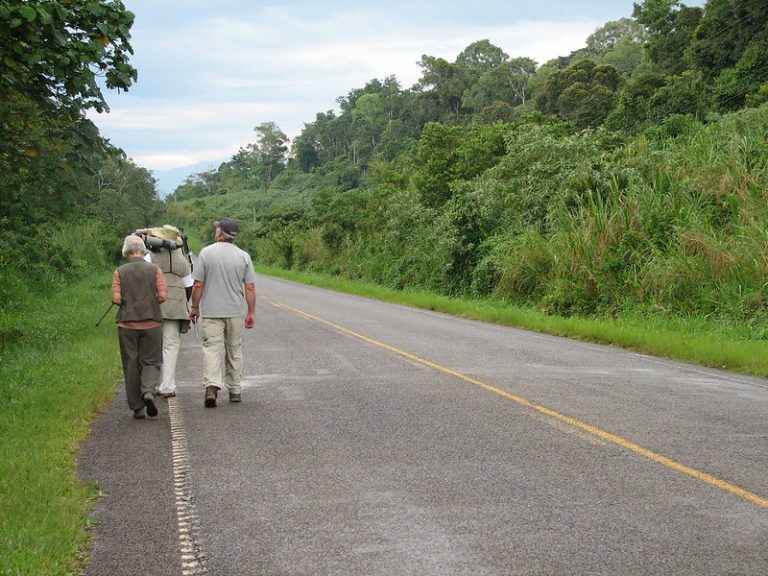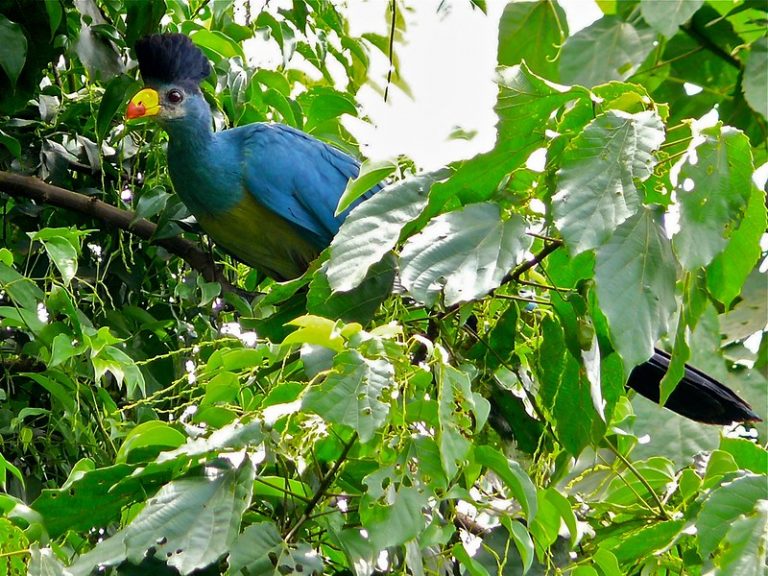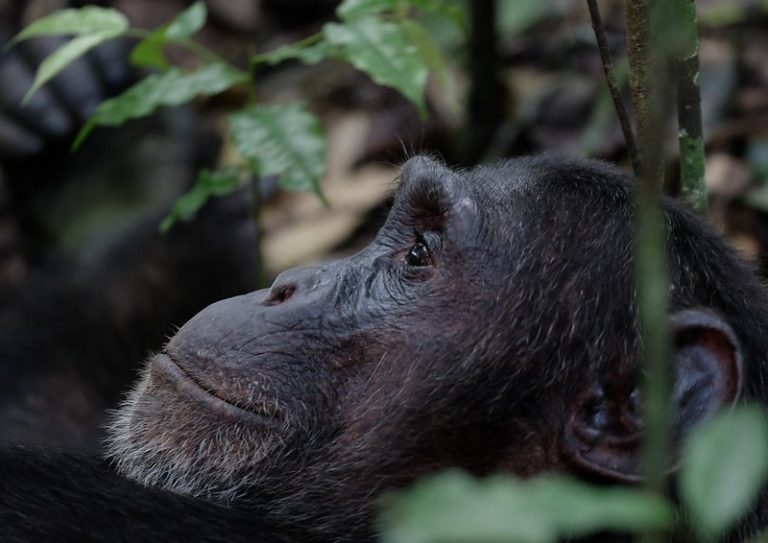-
Do gorillas eat humans?
Because of the sheer size and strength of the mountain gorillas, may people tend to wonder what these giant forest creatures eat to satisfy them? Well in reality gorillas are generally herbivores which implies that they mostly consume plants. They do not eat meat or even hunt down other animals as prey which means that they aren’t carnivores.
The largest portion of their diet is green (vegetation). They consume a lot of plant material which include leaves, bark, stems, seeds, young branches, and shoots. Among the numerous species of plants that the gorillas consume are: succulent herbs, bamboo, thistles, celery as well as nettles. They also enjoy wild berries especially when they get them. Each day an adult gorilla can eat as much as sixty pounds of food.
Once in a while, the gorillas also eat bugs and grubs. Also if they come across ants, they eat them. Snails and flowers are part of their diet occasionally. They hardly drink any water in the wild because most of the vegetation they consume is succulent enough to quench their thirst. Very rarely has the silverback been seen feeding in rotting wood as well as small animals. So just as man, gorillas can choose to eat plants or meat which makes them omnivorous.
The mountain gorillas have also been observed occasionally feeding on soil as well as ash in not very large portions; perhaps to help regulate their digestive systems. However I should emphasize, they do not eat humans.
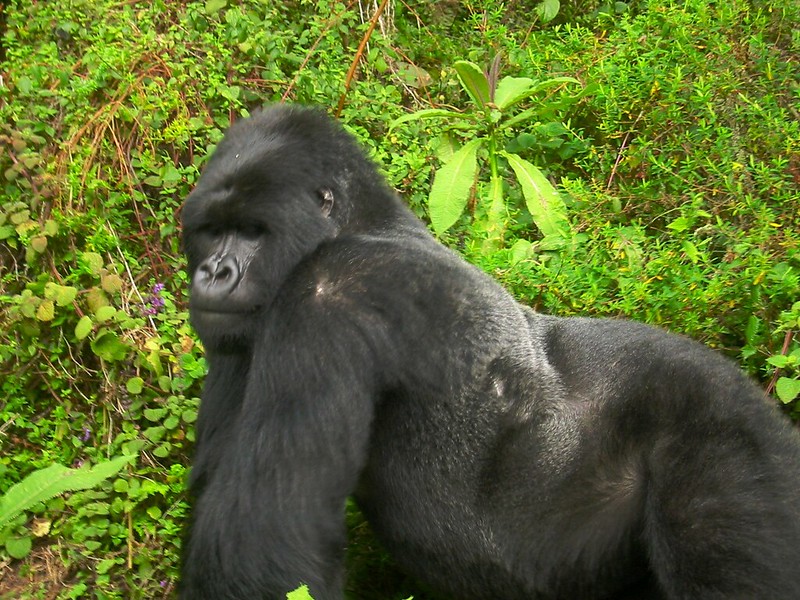
-
Physical Fitness requirement for a gorilla safari
When you set out hiking in an unfamiliar ground such as the Bwindi Impenetrable forest and the Mgahinga National Park in Uganda, or Virunga national park in D.R. Congo or the Volcanoes National Park in Rwanda, the experience can be rather challenging given that the landscape is unpredictable. generally all the habituated families inhabit the higher altitudes of the forests which are covered with intertwined undergrowth which where need be the lead guide tries to clear the forest trails with his machete. The lead guides who lead trekkers on this forest expedition are very professional, highly skilled and very knowledgeable about the gorilla habitat with several years of experience.
We recommend trekkers to adequately prepare for this expedition through constantly hiking prior to the safari to help familiarize their bodies with hiking for long distance and on high altitude. Another thing to also keep note of is that because of the thick canopy cover, sunshine penetration to the floor of the forest is minimal a thing that makes the trails muddy and quite slippery. Because gorilla trekking literal means following the gorillas from one place to another until you finally find them settled in one place, then be prepared to walk uphill and downhill as well as ready to hike for several hours on uneven ground. All this is quite energy consuming and very tiring but as earlier mentioned, once you finally meet them, the encounter is very mind blowing that you will agree with me that it was worth the long trek. During a gorilla trekking safari, you will spend on hour with the gorillas while during the gorilla habituation process; you will spend four (4) hours with them.
Some of the fitness tips I can recommend to you before your gorilla trek in Uganda, D.R Congo or Rwanda include: practice walking a lot from day to day as the activity includes a lot of walking, better to hike on elevated ground particularly with an ascending terrain; this will make your leg muscles stronger and familiarize your legs to such terrain, and also don’t forget to stretch at the end of your daily practice to avoid any muscle pains.
-
Where To see Gorillas in Africa?
Today, here are less than 900 Mountain gorillas remaining in the world. These can only be seen in only three countries: Uganda, Rwanda and the Democratic Republic of Congo – with Uganda having more than have of this number. Below we highlight details of these countries.
-
Uganda
10/10 Chance of seeing gorillas
Uganda offers two national parks where the gorillas can be seen and these are
Bwindi National Park
and Mgahinga National Park. These protected verdant
rainforests in Uganda
are is home to over four hundred (400) mountain gorillas which is half of their surviving population on earth today. To be precise, holiday makers can decide to visit the
Mgahinga Gorilla National Park
; however there is a more popular and home to a larger number of mountain gorillas – the Bwindi Impenetrable Forest National Park, which is located north of the Mgahinga approximately 30 miles away. the gorilla trekking expeditions in Uganda are all led by very professional and highly experienced park ranger guides who will lead you as you follow the footsteps of these forest giants until you reach where they will be. More enthusiastic can opt to take part in the
Gorilla Habituation
program. a maximum number of eight (8) people is allowed to visit each group, and each trekker will be required to get a gorilla trekking permit to take part in this very amazing activity. Gorilla Trekking Permits in Uganda cost $600 irrespective of which tourism season you visit.
-
Rwanda
10/10 Chance of seeing gorillas
found in the north-western corner of Rwanda is Volcanoes National Park whose verdant rainforests are home to a number of mountain gorillas a number of which have been habituated and can be visited by tourist. here holiday maker can get a chance to explore the great works done by Dian Fossey an American primatologist as well as conservationist who studied comprehensively about these forest beings and published a famous book ‘Gorillas in the Mist’ that caught the attention of many across the world about the significance of conserving the mountain gorillas. in Rwanda, a gorilla trekking permit is $1,500 each per person per trek
-
Democratic Republic of Congo
8/10 Chance of seeing gorillas
The Volcano Mountains shared by Uganda, Rwanda and Democratic Republic of Congo are covered with a thick rainforest that serves as a natural habitat to the mountain gorillas. So when you visit Congo, you will also have chances to see these hairy great apes. There are over one hundred (100) mountain gorillas living within the Virunga National Park of D.R Congo which is a UNESCO World Heritage Site. The cost of a gorilla trekking permit her is $400 per person.
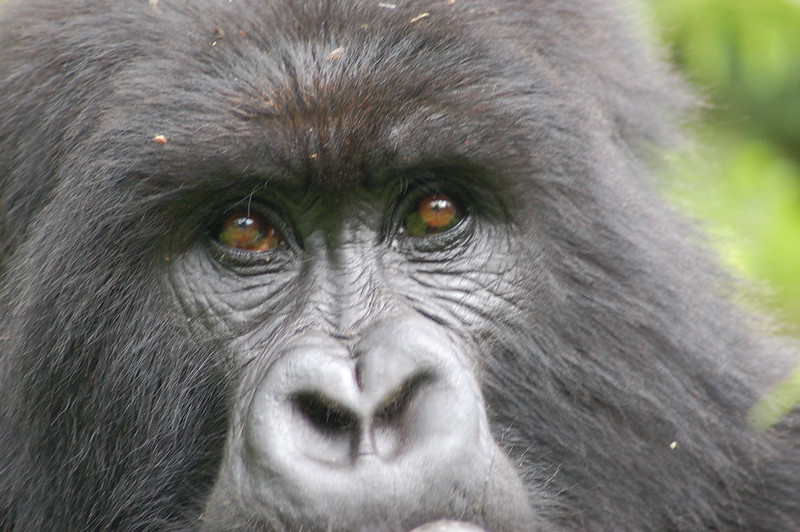
-
A Gorilla Photo Safari
There is nothing as captivating, and extremely satisfying as the feeling you get after trekking through the thick rainforest searching for them and finally sitting in the midst of them as you observe baby gorillas cling on their adult mothers, coming face to face with the giant dominant silverback, seeing the youthful ones playing about, it’s all unexplainable! You will capture very beautiful photographs in the one hour you will spend with gorillas.
For the holidaymaker very interested in photography, we recommend that you take a Gorilla Photo Safari in Uganda as no better words can be used to describe this destination than calling it a wildlife paradise. Currently there are more than 800 mountain gorillas found across the planet and thanks to the great conservation works being done by the wildlife authorities in the countries where these gorillas are found, this number is rising. Uganda is unique because it has more than half of this total population so expect to see a number of mountain gorillas.
You will be led by ranger guides during the search of the gorillas as they change their nesting places each day, so they will ensure that you remain a reasonable distance from the gorillas (a minimum of seven meters). As you approach the gorillas, the guide will tell you to prepare your photographing gear. We recommend that you take two cameras and maybe have one having a wide angle lens (or a wide angle zoom), and the second mounted with a 100-400, 70-200 2.8 or a 120-300 2.8. The Olympus digital camera with a 12-100mm lens is just right, whereas if you are a fun of the Canon brand, then a 28-300mm lens will also serve you right. For a Nikon camera, an 18-200mm lens will be an appropriate choice as well. Although a tripod will come in handy especially for lighting, a number of people consider using it quite challenging and opt to use either handhold or monopod.
Since they have been habituated, these gorillas do not mind human presence so you will be rewarded with perfectly ‘comfortable’ subjects to take shots at. when you visit Bwindi National Park, it is not only home to the mountain gorillas but has a variety of other wildlife and the country its self offers a great diversity such as the tree climbing lions, leopards, rhinos, elephants and the giant Nile Crocodiles in addition to a variety of birds. All these will definitely reward you with an accomplished experience of a wildlife photographer. Rwanda is another destination where you can enjoy a gorilla photo safari.
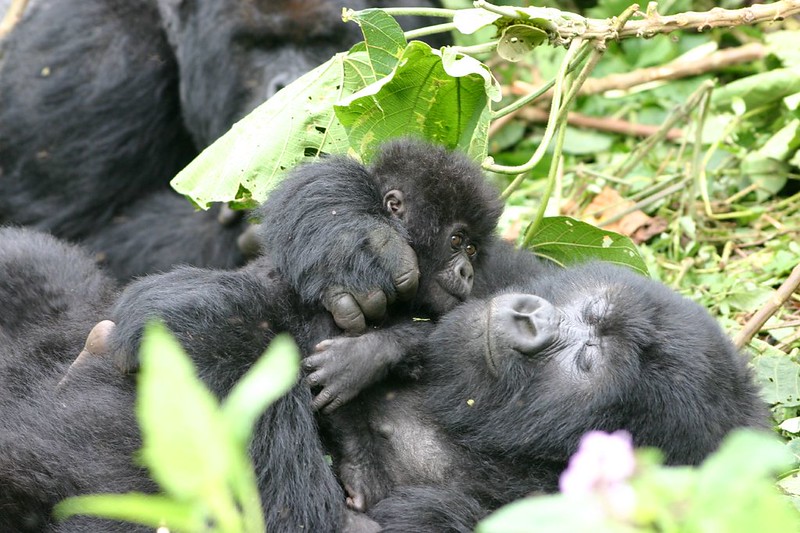
-
Where do Mountain Gorillas live?
The mountain gorillas are a sub-species of the eastern-gorillas and today there is a very small population of them remaining in the world. These are found in two main places, one population lives within the Virunga Mountains which are arrange of several extinct volcanoes that are shared by Uganda, Rwanda and the Democratic Republic of Congo. The other bigger half is found in the impenetrable forest of Bwindi National Park found in south western Uganda.
The mountain gorillas where first discovered in 1902, and through the course of time they have suffered several wars, disease, severe hunting as well as destruction of their natural habitat, and with all these threats subjected to them, it was assumed that the mountain gorilla species would be extinct today.
The gorillas live on high altitudes between 8,000 feet to 13,000ft in forested mountain slopes. The coats of their bodies have very thick fur which is actually thicker when compared to that on other Great Apes. Because they live on higher altitude within forested areas where temperatures can drop very low close to freezing, this fur helps them maintain body warmth for survival. Previously these gorillas did not live at such high altitudes in very severe conditions but because humans have continued to encroach on their habitat, they ended up driving them higher into the mountains.
Although poaching is a vice that is still being carried across the planet, civil wars and even human encroachment due to the increasing human population in the word today, it is with pleasure that I would love to inform you that the once upon a time dwindling number of mountain gorillas is now increasing. I cannot fail to mention the great tireless efforts that different organizations and governments where the amazing giants are found have done that also include sensitizing the local communities against the dangers of poaching.

-
How Much Does A Gorilla Safari Cost / fees ?
one of the common and unavoidable questions normally asked by holidaymakers while booking a safari is “How much does a gorilla safari cost?” different gorilla trekking packages come at different prices and one would wonder what causes this variation. Well, there are a number of factors that will affect the cost of a gorilla permit. I have highlighted them below.
The price of a trekking permit
Although gorillas can be seen in Uganda, Rwanda and D.R Congo, one thing all these destinations have in common is that one need a trekking permit to engage in this activity. In Uganda the permit costs $600, in Rwanda $1,500 while in the D.R Congo its $450. This variation alone will affect the overall cost of your safari
The Duration of your Safari
The more days you will spend on your gorilla trekking safari, the more costly it will become and this is mainly because other activities like cultural tours and wildlife game drives will be incorporated in it.
The type of Accommodation
Accommodation varies from camping, budget, mid-range to luxury facilities. So depending on your financial capability, the choice will be up to you. However because these gorilla sanctuaries are located in more remote parts of the countries, the overall rate of accommodation is higher compared to that in other safari destinations.
Mode of Transport to and from the park
Majority of the trekking destinations can be accessed either by road transport (this includes renting a safari vehicle, fuel, and a driver), or by air transport with various charter flights accessing the gorilla parks. Without a doubt the price of the charter flights is way higher than driving.
Company Service fee
Similar to other businesses, each tour company that organizes trips to see the gorillas includes a service fee and this varies from one company to another. This charge is used to pay the company employees such as the reservation officers and tour consultants.
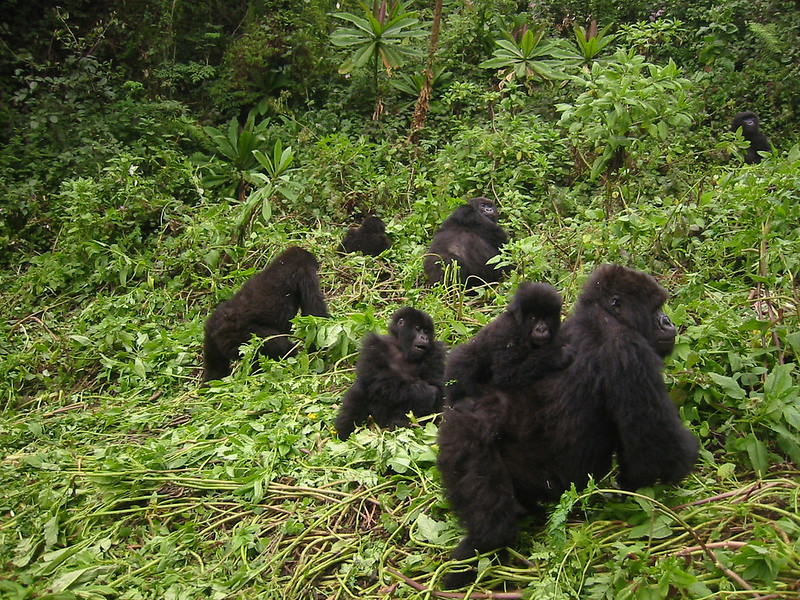
-
Camping on a gorilla trek
In Africa today, Gorilla Trekking is among the most expensive activities you can enjoy on your safari holiday to the continent. The main contributor to this elevated cost of a gorilla safari is the cost of a trekking permit which is a must-have requirement for anyone going to engage in this activity. In Uganda’s Bwindi National Park and Mgahinga National Park it costs $600, in D. R Congo’s Virunga National Park it is $450 whereas in Volcanoes National Park found in Rwanda it costs $1500. Remember that the trekking safari also includes transport costs as well as your accommodation. So in order to cut down the overall cost of the safari, you can opt for a camping gorilla safari in any of the three destinations: Uganda, Rwanda and D.R Congo where gorillas can be seen.
Fortunately, majority of the safari lodges found in the gorilla destinations such as Bwindi Impenetrable National Park offer space for camping. Looking at Bwindi NP for instance, camping grounds can be found in Buhoma Community Rest Bandas within the northern part of the pars, or a crater bay camp, or Nshongi Camp within Rushaga area of the park, or at Bunyonyi overland camp or even at Nkuringo camp. What will be required of you is paying the camping fee and afterwards you will be at liberty to pitch your tent. Those without camping gear can always talk to their tour operator who will assist in renting all the necessary equipment and bedding.
Through opting for a Camping Gorilla tour you can save more than sixty percent (60%) of the overall cost of your safari. you will either eat at the camp’s restaurant or opt to prepare your own meal. Good enough, there are several shopping centers and fresh fruit / vegetable markets you will find as you drive towards the gorilla destination, so en-route you can make shopping for all you will need to eat and drink. Such safaris are perfect for student study group tours and budget travelers. Always remember to book your camping space in advance through your tour operator. Above all security at the campsite is guaranteed.

-
Trekking Trails and Routes for Gorilla Walking Safaris
Today, there are less than 900 mountain gorillas remaining in the world, and these can only be seen in three (3) destinations that is: Uganda, Rwanda and the D.R Congo. These hairy giant enjoy staying in moist cold areas at altitudes between 2,000 and 3,000 meters above sea level. They stay in rain forests where rain is highly unpredictable. each of the gorilla destinations which include Mgahinga National Park, Bwindi National Park, Volcanoes National Park and Virunga National in D.R. Congo have a mountainous terrain that is covered with densely forested areas that will necessitate trekkers to trek for anything between two to eight (2 to 8) hours searching thorough the bushes and traversing the hilly un even ground. The forest trails are normally covered with thick bushes which are normally very challenging especially during the rainy season, with too much mud that makes them extremely slippery and tough to maneuver through. Consequently, this makes the exciting gorilla adventure quite a nightmare, and for that reason, we strong recommend that you inquire with your tour operator about the best time to visit which ever gorilla destination you will be going to, or simply opt for the dry months. Because of the thick undergrowth comprised of shrubs as well as thorny bushes which make traversing the trails quite difficult. It’s for that reason we recommend that you wear long sleeved shirts and trousers to avoid being pricked by the thorns. A walking stick will come handy as well in offering you support along the muddy trails. Another very important thing is strong hiking boots that offer ankle support. These will greatly be of help on your gorilla trek in their natural habitat.
At the park headquarters of each of the gorilla trekking destinations you will find porters ready to hire out their services to you through the hike. These will help carry your day pack as well as assist you while traversing the muddy slippery trails especially in the trickier and steeper sections of the forest trail. You should not in any way feel offended to hire a porter as it is a very common practice during this activity and it’s done by all trekkers irrespective of their age or hiking capability. the porter fee is between $10 and $20 dollars, and this money they use to sustain their families, so by hiring the services of a porter you are indirectly supporting the welfare of an African family; please don’t forget to tip the entire team at the end of the hike. It’s without a doubt that porter services will make your hike much easier as you take on the challenging forest trails in the gorilla habitat.
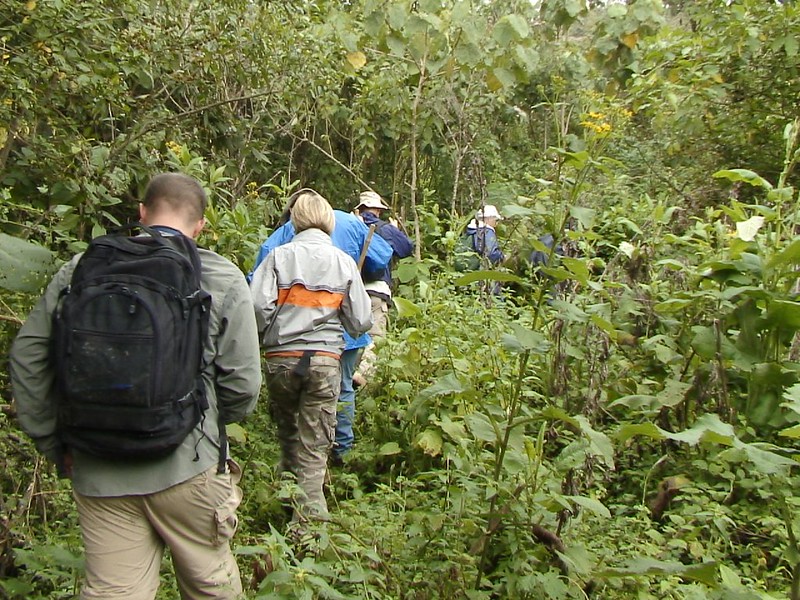
-
Cheap or Budget Gorilla Safaris in Africa
If we talk about trekking gorillas in Africa, one would definitely imagine a very expensive safari; however, with pleasure allow me to inform you that it is very possible to have a Budget Gorilla Trekking Safari.
One of the best ways to do this is to travel during the low season when the permits in destinations like Uganda (Bwindi impenetrable National Park and Mgahinga National Park) are reduced from the $600 rate in the peak season to $450 dollars. In D.R Congo, the permits are reduced to as low as $150 instead of the $450 of the peak season. Unfortunately the prices in Rwanda do not change – they remain at $1,500. These discounts are offered to offset the low number of tourists that visit in the off-peak season. During this season, the demand for the permits is very low which makes it easier to acquire them, hence reducing the time needed to book and acquire the permit by the tourists.
Another amazing thing is that because the number of trekkers in the low season is smaller, each gorilla groups is allocated less than the eight (8) usual people to visit it thus offering trekkers a better, more personal experience with the gorillas.
The best point about this is that the accommodation facilities – lodges and tented camps in and around the gorilla habitats offers reduces prices as well as a result of the low occupancy numbers. So visitors at this time of the year receive very good quality services at discounted rates as compared to the peak tourist season. This also applies to the rates offered for air tickets; most couriers offer discounted fares.
The lower season is basically the rainy months of the gorillas’ destination. In Uganda for instance this is from February to May and also in the month of November. However you should always remember that they since their habitat are a rain forest, it rains any time irrespective of the season, so this will not affect the gorilla trek. The vegetation is very green and offers amazing photography opportunities.

-
Gorilla Safari Accommodation with Tripadvisor Reviews
Gorilla Forest Camp – Bwindi NP, Uganda
This is among the best luxury lodges found within Uganda. It is located within the boundaries of the national park and offers accommodation in nice tented camps within exceptional superb customer service. It has a beautiful mini spa and the entire facility has been impressively furnished.
Mahogany Springs
– Bwindi NP, Uganda
The Mahogany Springs is a fairly new facility within Bwindi and has fast become a favorite among holiday makers visiting the Bwindi Gorilla habitat. It offers great luxury accommodation services, offers a modern experience as compared to its counterpart forest lodges. I can’t however fail to mention that the good service comes at a great rate.
Clouds Mountain Gorilla Lodge
– Bwindi NP, Uganda
The luxury Clouds Mountain Gorilla Lodge offers the best views within the park. It is located in the southern part of the Bwindi on the Nteko ridge, and overlooks the verdant floor of the Albertine Rift valley extending to the Virunga pointy peaks.
Gorilla Safari Lodge
– Bwindi NP, Uganda
This amazing lodge is the perfect place to set base when going to trek gorillas because of its location. Great food, comfortable accommodation and good quality service offered by a very hospitable of staff is what you should expect. The amazing luxury lodge is located on the border of Bwindi National Park.
Sabyinyo Siverback Lodge – Volcanoes NP, Rwanda
Sabyinyo Silverback Lodge is found on the lower slopes of the Virunga Volcanoes, not far from the main gate into the park. Because of its location, it is the most ideal place to set base for your gorilla trekking safari. Constructed and run by Governor Camp, the Sabinyo Silverback lodge belongs to the local community trust and the revenue generated from it is used to support the various social and economic projects in the community. Each of its eight (8) cottages enjoys breathtaking views of the volcanoes as well as the nearby green countryside.
Le Bambou Gorilla Lodge, Volcanoe NP, Rwanda
The Le Bambou Gorilla Lodge is located at the foothills of volcano Mountains near the Volcanoes National Park habitats to the endangered Mountains Gorillas. It seats within Musanze district in the northern province of Rwanda and it’s nestled within a Bamboo forest. They offer a wide variety of tasty food on their menu, comfortable accommodation as well as good quality service offered by their very welcoming and highly hospitable team of staff. A splendid experience awaits you in this small but amazing country in Africa where you will be able to share space in the natural habitat of the endangered mountain gorillas.
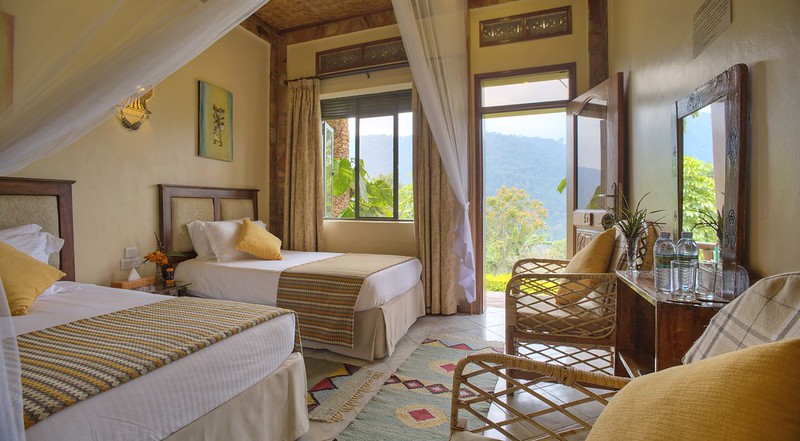
-
Silverback Gorilla; Habituated Gorilla families
Mountain Gorillas live in organized families with adult males and female, juveniles and babies. Each family is led by a dominant adult male with silver hair on the back of it coat a reason why it’s called the
Silverback
Gorilla
. When male gorillas grow, they mature from being black backs and the hair on the back of their coats gets a characteristic silver color. It’s the duty of the dominant silverback to protect and guide the family on where to go. Dominancy over a family can only be achieved through of overthrowing the ruling silverback in a very challenging fight.
Below are the habituated gorilla families found in the different gorilla destinations in the world
Bwindi Impenetrable National park, Uganda:
this is the best and most popular destination to see mountain gorillas in the whole world. It is estimated that it has more than 500 gorillas (which is over half the world’s population) living within its forest comprised of more than 37 families of which only 19 have been habituated for tourism activities. These include:
- Mubare Gorilla Family – 9 members
- Habinyanja Gorilla Family – 18 members including
- Rushegura Gorilla Family – 19 members including
- Katwe gorilla family – 7 members
- Nkuringo Gorilla Family – 19 members
- Bushaho gorilla family – 8 members
- Bitukura Gorilla Family – 14 members
- Mishaya Gorilla Family – 7 members
- Oruzogo Gorilla Family – 23 members
- Nshongi Gorilla Family – 18 members
- Kahungye Gorilla Family – 13 members
- Bweza Gorilla Family – 9 individuals
- Kyaguriro Gorilla family – 20 individuals
- Bikyingi Gorilla Family – 21 individuals
- Christmas Gorilla family – 9 members
- Mukiza gorilla family – 10 members
- Kutu gorilla family – 8 members
- Mucunguzi gorilla family – 8 members
Mgahinga National Park, Uganda
There is only one habituated group the Nyakagezi family with 9 members
Volcanoes National Park, Rwanda
- Susa A family – 33 members
- Sabyinyo family – 13 members
- Amahoro – 17 members
- Group 13 family – 13 members
- Kwitonda family – 18 members
- Umubano family – 11 members
- Hirwa family – 13 members
- Agashya family – 13 members
- Karisimbi Family – 16 members
- Ugenda Family – 11 members
- Bwenge Family – 11 members
- Titus Family –
Virunga National Park, Congo
- Kabirizi Gorilla group – 19 members
- Humba Gorilla Group – 9 members
- Rugendo Gorilla Group – 9 members
- Mapuwa Gorilla Group – 22 members
- Lulengo Gorilla Group – 9 members
- Munyaga Gorilla Group – 7 members
- Nyakamwe Gorilla Group – 11 members
- Bageni Gorilla Group – 26 members
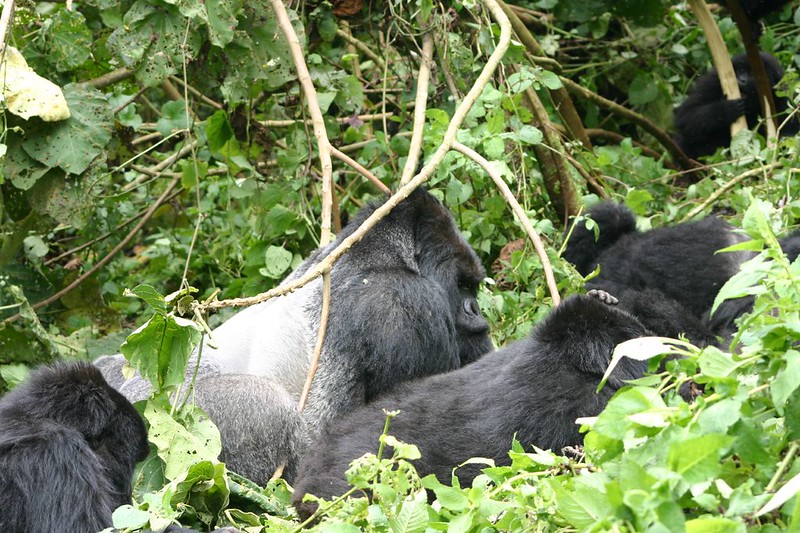
-
Best Gorilla Safari Holiday Destinations
Uganda
Destination Uganda is home to the largest number of Mountain gorillas supporting more than half of their total population and it offers the best authentic gorilla trekking experience. It has two gorilla natural habitats: the Bwindi Impenetrable National Park (a World Heritage Site) which is home to more than 37 gorilla families of which 19 have been habituated for tourism activity, and the Mgahinga National Park home to one habituated gorilla family. These forest giants live in the thick, cold damp rainforests in these sanctuaries so trekkers are always advised to carry a raincoat and a warm layer of clothes since it can rain any time irrespective of the season. The cost of a trekking permit is $600, and the country can best be visited in the dry season in the months of January to February and June to September. it can accessed by road or through charter flights.
the best part of trekking in Uganda is that you can easily combine your safari with other activities such as Chimpanzee trekking in the nearby Kibale NP, or game viewing of Africa’s Big Five Animals in any of its numerous wildlife parks as well as water adventures like white water Rafting on river Nile which is the source of the longest river on earth.
Rwanda
In Rwanda the rainforests of Volcanoes National Park is the home to the mountain gorillas and it is found just 80 kilometers from Kigali the capital city of the country making it the most accessible habitat of these great Apes. The park has nine (9) habituated gorilla families. During your visit, you can also check out the great works of the Dian Fossey a primatologist who did pioneering research and conservation works on the mountain gorillas in this area. She was buried alongside her favorite gorilla – Digit in the park. The cost of a gorilla permit is currently $1,500. It can be accessed by road transport on a three hours drive.
The park can best be visited in the dry season from the month of June up to September and then from December up to February. The months of October and November as well as March and May are rainy months.
Democratic Republic of Congo
Within the
Virunga National Park
comprised of a number of volcanic mountains you will find the amazing mountain gorillas that found a safe heaven on the forest slopes of the park. There are several families of gorillas living here, however more than ten (10) families have been habituated and are open to tourism activities. Today the cost of a gorilla trekking permit in the D.R Congo is $450 during the peak season while in the off peak season, a special discount as low as $150 is offers. The best time to visit these hairy forest giants is during the dry season when the forest trails are not very challenging to traverse.
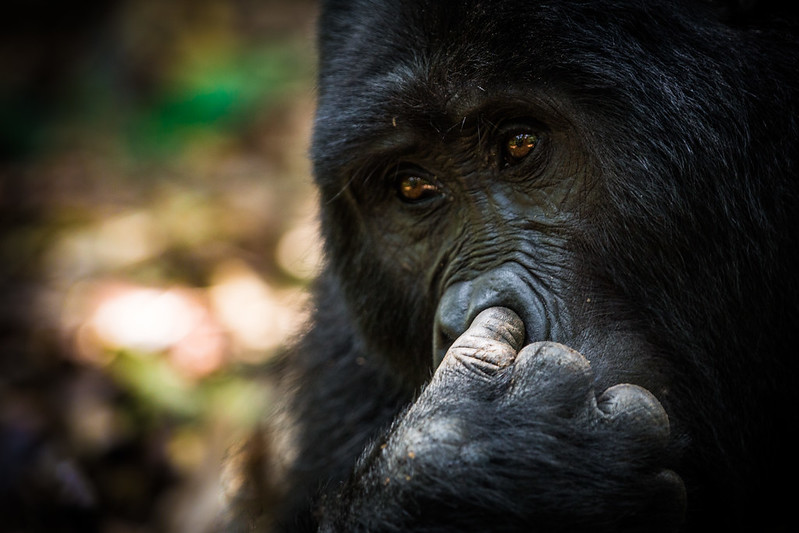
-
Is a gorilla safari for Luxury travelers?
Well for most people, gorilla trekking is an activity for luxury holidaymakers; however, this assumption is extremely wrong. Even a budget traveler can get a chance to enjoy this life memorable activity. there just a few guidelines that I am going to share with you which will help cut the overall cost trekking.
-
Travel in the low season
: during that time, most of the accommodation facilities in Uganda, Rwanda and the D.R Congo offer discounted lodging rates compared to during the peak season. The services are equally good and the facilities are less crowded due to the lower turn-up of guests. Alternatively you can choose camping for accommodation and actually get to lower the cost further. This will involve either eating at the cheaper campsite restaurants
-
Aim for discounted permits
. In some destinations like the D.R Congo, they offer discounted permits in the low season and these are reduced to as low as $150 – this will certainly reduce the cost of your safari.
-
Travel as a group
. When you safari as a group, costs such as transport (that include car rental fee, fuel and guide fee), as well as shared-hotel rooms are shared by the entire group bringing down the overall cost of the safari.
-
Choose your destination wisely
. Well what is common among all gorilla trekking destinations is that each of them requires trekkers to acquire a gorilla trekking permit before engaging in this amazing activity. These permits are sold at different rates in each country so as you choose where to take your safari please highly consider this. In Uganda it costs $600, in D.R. Congo – $450, while in Rwanda it costs $1,500.
-
Cultural Experience During or after gorilla trekking
When you visit any of the gorilla sanctuaries, you will discover that there were native communities that previously shared the rainforests with these huge hairy creatures. These communities can be visited during Cultural safari experience before and after your gorillas trekking safari. Below I have highlighted them basing on each sanctuary.
Batwa Cultural Experience – Bwindi National Park, Uganda
: you will get a chance to meet the Batwa pygmies and share their amazing traditions and great heritage of a people that once inhabited the impenetrable forests. Led by a Batwa guide, you will hike through the forest, see their hunting and survival skills when they were still lived in the forest, visit one of their homesteads, learn and even participate in their traditional cooking ways, as well as learn how to use the bow and arrow.
The Iby’iwacu Village cultural Tour – Volcanoes National Park, Rwanda
. Visit this amazing village where the locals have convinced a number of former poachers to return to their previous way of life and even form a traditional dance group which entertains tourists that visit their village. you will enjoy a detailed tour led by one of the local guides taking you thorough the lifestyle, show you how they have survived over the years as well as get a chance to engage in some of their activities.
Batwa Cultural Trail – Mgahinga National Park, Uganda:
During this cultural experience you will get a chance to meet the batwa pygmies who were displaced from Mgahinga after it was declared a national park. You will be led on a trail and be able to see the wonders of the forest through the eyes of these people.
Batwa Cultural trail, Virunga National Park D.R Congo
: in Virunga, the Batwa live on the edge of the park’s forests. They will lead you on a cultural experience during which you learn about their different traditions and practices such as making of huts, taste some of their traditional food, learning their hunting skills and enjoy traditional entertainment of music dance and drama.

-
Best places in the world to see gorillas
Mountain gorillas can only be seen in three countries across the entire world and these are Uganda, Rwanda and D. R Congo. Because of their human-like nature, visiting the gorillas has become a popular activity among holidaymakers. Below we have briefly talked about these gorilla trekking destinations.
Uganda:
gorillas here can be seen in Mgahinga Gorilla National Park and Bwindi Impenetrable Forest National Park, and the country has over 400 mountain gorillas which is more than the world’s total gorilla population. Uganda offers more habituated groups open for tourism (Bwindi national park offers 19 habituated families while Mgahinga offers one habituated family) and will reward you with a more authentic gorilla trekking experience when compared to the other destinations. Although the activity can be done throughout the year, the best time for trekking is in the dry season from January to February, the June to September.
Rwanda
: within Volcanoes National Park found in the northwestern part of the country is where these amazing gorillas can be seen. The park has about 176 gorillas among which are 10 habituated families open for tourism. Here you will also be able to visit the Dian Fossey gorilla Research center which she (Dian a long ago primatologist and conservationist) established while she research about the gorillas. The park can be visited all year round; however the best time to go is in the dry season from mid-December to February and then June to September.
Democratic Republic of Congo:
within the rainforests of the Virunga National Park have the mountain gorilla made their home. The park has around 100 gorillas and offers around eight (8) habituated gorilla families which can be visited by tourists. the park is also open all year round however the dry season will offer you a more enjoyable trekking experience from January to February and then from June up to September.
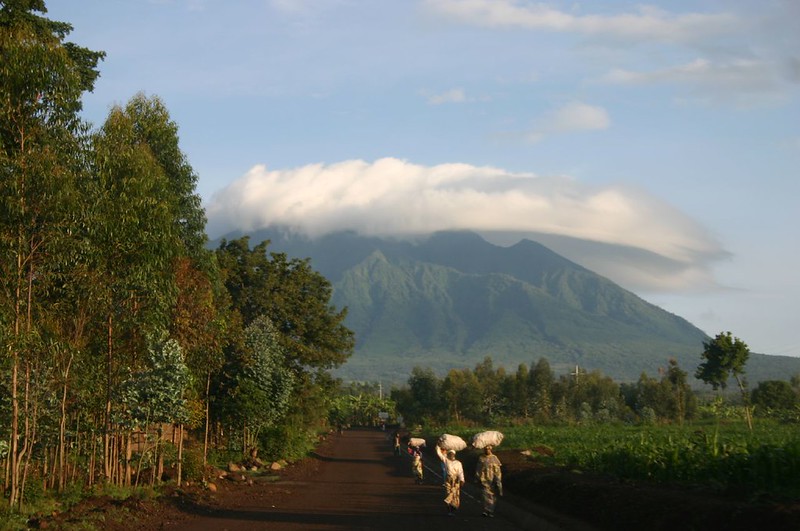
-
How much is gorilla trekking in Uganda
This is one of the commonly asked questions among primate lovers who would love to visit the mountain gorillas living in Uganda. Well there are a number of factors that will contribute the overall cost you will pay for your Uganda Gorilla trekking safari just as we have highlighted below
Cost of Gorilla permit:
Today a gorilla permit costs six hundred US Dollars ($600) during the peak tourist season of June to September as well as December to February; while in the off-peak season of April, May and November it cost three hundred and Fifty US Dollars ($350)
Cost of Transport
: secondly you have to plan as well as budget for transport to and from the Bwindi National Park or Mgahinga National Park where you will be trekking. This will include the cost of renting a safari car, the fuel to drive you on the 526 kilometer journey to and from the gorilla sanctuary as well as the cost of a driver-guide. Normally the trek takes three days with you driving to the par on the first day, second day is for trekking the gorillas and the third day will be for returning to Kampala. However, there is an option of flying to the park through the charter flights offered by Aero link which lands at Kihihi Airstrip – the closest to the park.
Cost of accommodation
: you will need a minimum of two nights in the park (the arrival night and the trekking night). The type of accommodation facility you will stay in will greatly determine the overall prices as these vary from budget facilities, mid-range facilities to the luxury facilities.
Additional Activities on the safari
: there are a number of other optional activities such as the Batwa cultural experience, or bird watching, or the habituation experience you may want to do while in the gorilla sanctuary which come with an additional cost. also Uganda is quite a unique destination as a gorilla safari can be combined with other exciting adventures such as game rides to see Africa’s big Five, Water adventures like white water rafting, Chimpanzee trekking, boat rides, mountain climbing to mention but a few.. all these will certainly determine the cost of your safari. So prior to booking a safari, carefully calculate the estimated cost and see if the cost suits your budget.
![]()
-
What are the gorilla trekking rules and regulations?
A number of rules and guidelines have been put in place for the safety and well-being of the mountain gorillas. These forest giants are not only very susceptible to human diseases as well as prone to infections especially when the visitors draw very near to them or show up in excess numbers, but also become troubled. So these guideline listed below have been put in place for the good of the gorillas and the tourists visiting them
Rules before leaving for your gorilla trek:
In a single day, the greatest number of visitors allowed to see the family of habituated mountain gorillas is eight (8). This reduces the chances of being exposed to human infectious diseases as well as behavioral difficulties.
Prior to seeing the gorillas, always wash your hands well.
Rules to follow in the Gorilla Habitat (forest):
The place where the guides saw the gorillas a day earlier is where you shall be taken. From that point, you will go after the gorillas’ tracks to locate them. On the way, keep an eye out for the nesting sites of the gorillas as you trek.
Kindly lower your voices at all times; that way you will be able to see the wonderful bird life plus a number of other animals living in the forest as well.
Never litter or leave rubbish in the park. In case you carry an item, you should take it back with you.
The guides will let you know once you get close to the mountain gorillas so that you can adequately prepare yourself.
Rules to follow when with the gorillas:
From the gorillas, a distance of 21 feet (7 meters) should always be maintained. The group will be more comfortable if you stand further away.
Stay close to each other as you approach the gorillas; always remain in a group.
Asking questions is acceptable although the voices should always be at a low tone.
In case you are taking photos, walk gently and cautiously. Taking photos using a camera with a flash is not allowed.
Eating, drinking, or smoking in the presence of the gorillas is not allowed since drinking or snacking will unavoidably increases the chances of food particles or droplets from any drink falling on the ground which may consequently increase the threat of disease transmission.
The gorillas are wild creatures so avoid any contact with them; never touch them.
The gorillas get irritated at times. if they do so, please comply with the guide’s instructions and examples such as hold back as the animals are moving (they have the right of way), slowly squat down and avoid looking the gorillas eye to eye).Trying to run should be avoided as that will only escalate the danger.
The longest time to spend amidst the gorillas is an hour although the guide may cut the visit short in case the gorillas get upset or uneasy.
As you leave, keep your voices down until you are a distance of two hundred meters from the mountain gorillas.
Health rules to follow:
Do not forget that the gorillas are very vulnerable to human sicknesses. The rules below are in place to reduce the dangers associated with visiting gorillas.
The restrictions stipulated on the permitted visitor numbers to see the gorillas on a daily basis should be observed. This reduces on the chances of spreading diseases as well as straining the gorilla family.
Kindly volunteer to be left behind if you have an infectious disease or are sick. Your money will be repaid back or an alternative tour will be organized for you as per the refund and cancellation policy of the regulatory authority.
Kindly shield your mouth and your nose and face the opposite direction from the gorillas if you get the urge to sneeze or cough especially when you are in their midst. This reduces the circulation of viruses or bacteria.
To protect the gorillas from getting human illnesses, stand 21 feet (7 meters) far from the gorillas at all times.
Foreign items like food wrappers may contain diseases or other pollutants therefore avoid leaving any garbage within the park.
In case you want to use a toilet in the forest, kindly inform the guide who will dig a hole using his panga. Ensure it is a deep thirty centimeter hole and after you have finished, close it up with soil.

-
What about the gorilla habituation experience
What is Gorilla habituation?
It is a gradual and tender introduction of the human presence to a family of wild gorillas. The wild gorillas are habituated to enable researchers study about them so that they can safe guard them from poachers, medicate their wounds and illnesses as well as through sustainable tourism promote their conservation. Presently in the Rushaga region of Bwindi Impenetrable National Park, a pair of gorilla families – Bushaho and Bukingyi, are being habituated. Each gorilla family has been subjected to a long habituation in order to familiarize them with the human presence a process that takes between two and five years. The process is managed by a group of expert researchers, rangers, trackers as well as conservationists
The habituation process:
at the beginning of the habituation process, every day the park rangers spend a limited time with the gorillas by keeping a particular distance that is comfortable for the gorillas. The time spent with the apes slowly increases every couple of months as the distance decreases up to a point when the rangers are sure the gorillas are prepared to receive visitors. The gorilla habituation experience makes sure that the gorillas in the presence of humans are completely relaxed since those that are not yet fully habituated may not be familiar with tourists or strangers although they may be accustomed to the habituating team. Each time you take part of the Gorilla Habituation Experience You will be supporting the important work done in habituating these forest giants gorillas and working towards their safe survival. The thought of being among the first humans to interact with these gorillas is quite extraordinary. This entire experience provides a more peaceful and warm encounter with the forest apes. You will completely appreciate this wildlife encounter since you will have a lot of time and also not feel too rushed.
Cost of gorilla habituation permit, number of people to visit and time spent with the gorillas
A gorilla habituation permit costs $1,500, and a maximum of four people are allowed to take part in this experience and enjoy four hours with the semi-habituated gorillas.
When and where to go:
from June to October as well as December to March are the perfect times to engage in this amazing activity in Uganda’s Bwindi National Park.
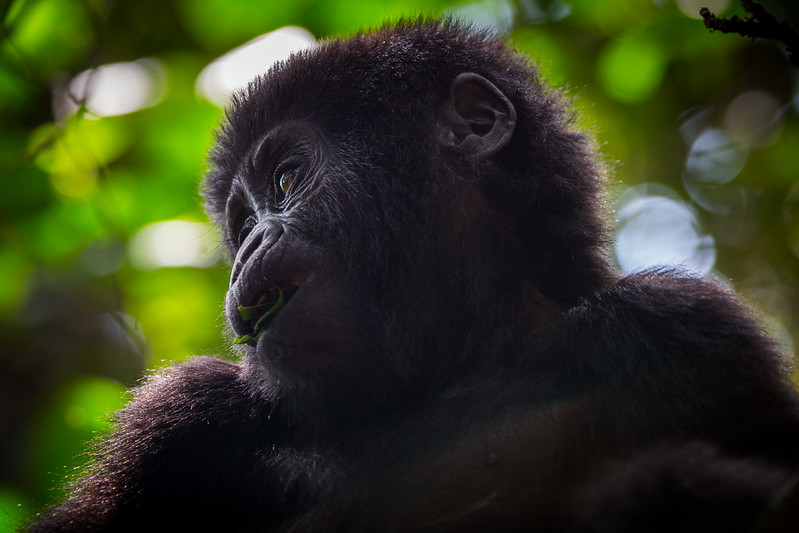
-
Gorilla Permit Cancellation policy
Currently, many African safari tourists have included on their bucket lists traveling to look at the mountain gorillas since it is a one of a kind experience. As a result of the high demand, the first step any tourist who are planning on seeing the mountain gorillas should do is booking a gorilla permit which should be done as soon as possible. No tourist is authorized to visit these vulnerable primates without a pass – the gorilla permit. The authorities that issue out the permits work under the government tourism and conservation industries in the respective countries, and these are: the Rwanda Development Board (RDB) in Rwanda and the Uganda Wildlife Authority (UWA) in Uganda. Before you book any gorilla safari, checking and confirming the accessibility of the gorilla permits on the days of your safari is highly recommended. In order to book a gorilla permit, you are required to make a 30% down payment. it is advised that you book your safari at least six months Before the actual date of trekking in order to guarantee availability of a trekking permit.
Cancellation Guidelines
Cancellations as well as changes in booking of gorilla safaris are unavoidable just as it is with other safaris basing on the current circumstances. To avoid any final hour disappointments, we outline for you the cancellation policies of gorilla permits that must be understood and read by all persons interested in this activity.
In Uganda,
the repayment on the gorilla permits and the cancellation policy is noted below:
In case a visitor is unable to make it due to sickness, UWA will reimburse 50% of the tracking fee and it will be at the recommendation of the warden responsible.For the visitors who have already tracked MNGP or the BINP, this clause applies to them.
A full compensation will be given on the permits of the visitors who are unable to see the Mgahinga National Park’s gorillas because of their movement to the bordering country. A 75% refund of the tracking fee will be given to those who have for whatever reasons have been unable to see the gorillas after tracking them all day long. The Reservation office in Kampala at the UWA Headquarters will affect all refunds.
Upon cancellation, UWA will effect the following refunds
There will be no refund between zero to eight days of the tracking date
25% will be refunded to the client between nine to forty-five days of the tracking date
50% between forty-six to ninety days of the tracking date
75% will be repaid to the client for ninety-one days and above to the tracking date.
Any repayment given on the 30% deposit will be at the permit’s value.
In Rwanda
, The Rwanda Development Board will refund 50% of the permit fee for any one showing signs and symptoms of sickness. The sick shall not be permitted to track once confirmed unfit by the in-Charge Warden. These conditions apply to visitors who have travelled into the park.
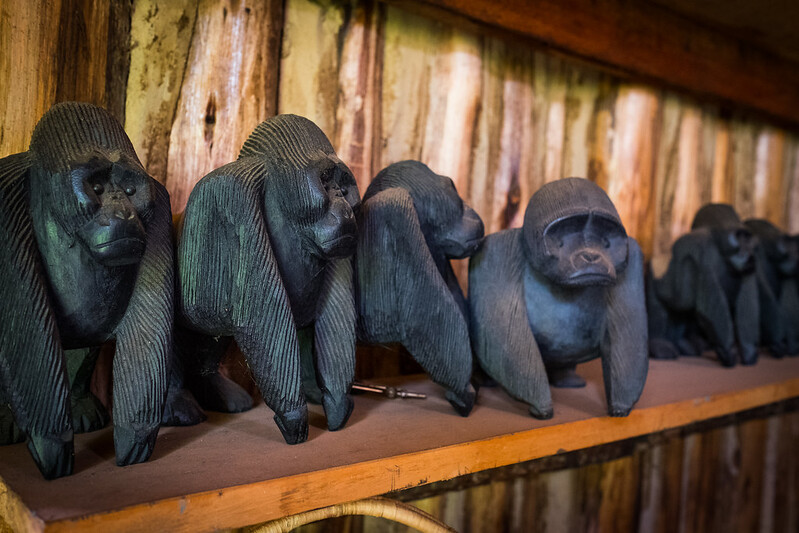
-
Can I trek Uganda gorillas from Kigali?
Yes you can. Today gorilla trekking Safaris from Kigali to Bwindi or Mgahinga National Parks in Uganda have become very popular and this is because most holidaymakers want to escape from the full day long drive from Kampala or Entebbe to the gorilla national parks. In the past gorilla used to be a favorite destination for gorilla enthusiastic but with the doubling of it gorilla trekking permits to $1,500, many tourists have diverted their attention and interest to Bwindi National park in Uganda. In fact today short trips can be conducted from Kigali to Uganda. Rwanda becoming an access point to the remote Bwindi National Park and Mgahinga National Park found in the far southern part of the country (closer to the Rwandan border) has become very good news for Uganda as a destination.
From Rwanda’s Kigali international airport to Uganda’s Bwindi impenetrable National park which is home to the largest number of mountain gorillas in the world, it is only 3 to 4 hours’ drive. You can access the park via Kisoro District through the Chanika border or via Kabale district going through the Katuna Border.
Mgahinga National Park also found in western Uganda which has three of the seven virunga volcanoes that are shared between Uganda, Rwanda and D.R Congo is another place where mountain gorillas can be trekked in Uganda. It is home to more than eighty (80) mountain gorillas and has one habituated gorilla which is open to receive visitors on Mountain gorilla safaris. Trekking in Uganda through Kigali will save trekkers a full night in other words, instead trekking for three days and spending two nights on the safari, you can trek in just two days and spend on night on the safari which will bring down the overall cost of your gorilla trekking safari.
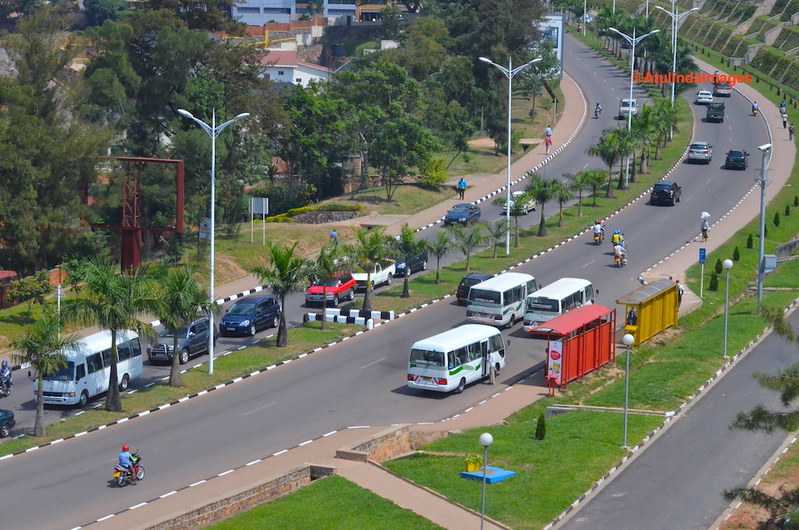
-
When to book for a gorilla permit?
In order to take part in gorilla trekking, all travelers are required to have a gorilla permit. It is recommended that they pay a deposit for the gorilla permit beforehand. All gorilla destinations including Rwanda, Democratic Republic of Congo as well as Uganda require all tourists going for gorilla tours to have gorilla permits. Although travelers pay the deposit for a gorilla permit, very few understand the relevance. The cost for gorilla permits is highest in Rwanda at 1500 USD, followed by Uganda whose permits go for 700USD for foreign non-residents, 500 USD for foreign residents and UGX 250,000 for East African residents. Democratic Republic of Congo has the cheapest tickets at 450USD but is the least visited due to instability caused by the civil wars in the country especially in Virunga National Park and other tourism destinations. Each traveler is expected to present a valid gorilla permit before they can be allowed to go for gorilla trekking.
trekking Mountain Gorilla is on the bucket list of most travelers from all parts of the world with over ninety percent (90%) of the tourists coming to Uganda, D.R Congo and Rwanda taking gorilla trekking as the main safari activity on their adventure. with only eight people allowed to visit a gorilla family each day, this results into a limited number of permits yet there is a very high demand for them. therefore it is better to book early by paying the deposit in order to increase your chances of getting a gorilla permit. Priority is given to people that pay early (they are awarded on a first-come-first serve basis), so you are encouraged to book as early as possible to be able to guarantee the availability of your gorilla permit considering that they are few. The demand for gorilla permits in Uganda especially during the peak season in the months of January, February, July, June, September, August plus December has become extremely high following Rwanda’s doubling the cost of its permits to $1,500.
![]()
-
What Is Included In A Gorilla Tour Cost?
Many travelers are very interested in the estimated cost of gorilla tour when it comes to reservations and booking of gorilla tours, one of the frequently asked questions is ‘what is included in the cost of a gorillas safari’. Most travelers want to know about a gorilla safari and find out whether it is budget friendly however the cost of each gorilla tour varies based on the package you want.
The cost of the gorilla tour covers your entire tour from the beginning to the end which includes;
Trekking Permit
: In Uganda, a gorilla trekking permit goes for 600USD for foreigners that do not stay in Uganda or in any of the countries in the East African Community, 500USD for foreigners that stay in Uganda and countries of the East African Community and UGX250,000 for citizens of the East African Community. Rwanda trekking permits go for as high as 1500USD during the peak season and 1050USD during the low season. All these prices are for each person per trek.
The length of the tour:
The price range of each package is dependent on the duration of the trip. Longer trips are more expensive than shorter trips because of the additional activities such as golden monkey trekking and cultural tours included in the itinerary.
The cost of accommodation
: Accommodation costs increase or decrease depending on the quality of the facilities you want to stay in; that is budget, midrange or luxury. Trekkers that stay in a budget or midrange hotel spend a lot less money than those who stay in luxury facilities. Sharing rooms on your safari will greatly reduce costs.
Transport and the driver guide:
You need a comfortable way of moving around as well as an experienced and qualified driver-guide to show you the tourist sites. The cost of transport varies depending on the type of vehicle you would like to use, the distance you will cover as well as the fuel consumption of the vehicle. Other people prefer taking charter flights to the gorilla destination which will also shot up the cost of your tour.
Company Service Fee:
The money that you pay to your tour company is reliant on the company you use. Every company charges a gorilla service fee that is mainly used to pay its workers in the office.
En route meals and drinks:
For long trips like from Kampala to Bwindi impenetrable forest national park, or Mgahinga in Kisoro district, travelers are provided with en route meals and soft drinks. The company caters for these meals from money the travelers pay to the company.

-
What Is The Gorilla Trekking Age Limit?
The restricted age for gorilla trekking is 15 years in Uganda and Rwanda. Many tourists are inquisitive about the minimum age for gorilla trekking because they want to travel with their children and want to know if they are allowed to go for gorilla trekking. Currently the rules and regulations governing gorilla trekking in Uganda and Rwanda in Bwindi Impenetrable National Park and Volcanoes National Park respectively put the gorilla trekking age limit at 15 years and older.
You can travel with your little ones above the age of 15 years rest assured that they can experience the gorilla trekking adventure without being prohibited in both in Rwanda and Uganda.
Children under the age of 15 years can only be allowed to go for gorilla trekking if they have special permission from the authorities and the child should be about 6.0 inches tall and only a couple of months to her or his fifteenth birthday. The child should be in great physical shape to take on the challenge however there is no assurance that the authorities will grant this permission even then you can try and see.
Children below the age limit of 15 years are generally not allowed to go gorilla trekking because gorillas are volatile animals and could charge and a child below the age of fifteen may not have been attentive during the briefing session and may not know the do’s and don’ts in such a situation. Little ones are prone to play frequently and could slow down the speed of the entire group while trekking towards the mountain gorillas because they get distracted easily looking at the new and different things around. Bwindi Impenetrable forest is especially very thick which makes it very hard for children below the age of 15 to follow the trails due being physically unfit for the journey and low levels of energy compared to energy found among people above the age of fifteen.
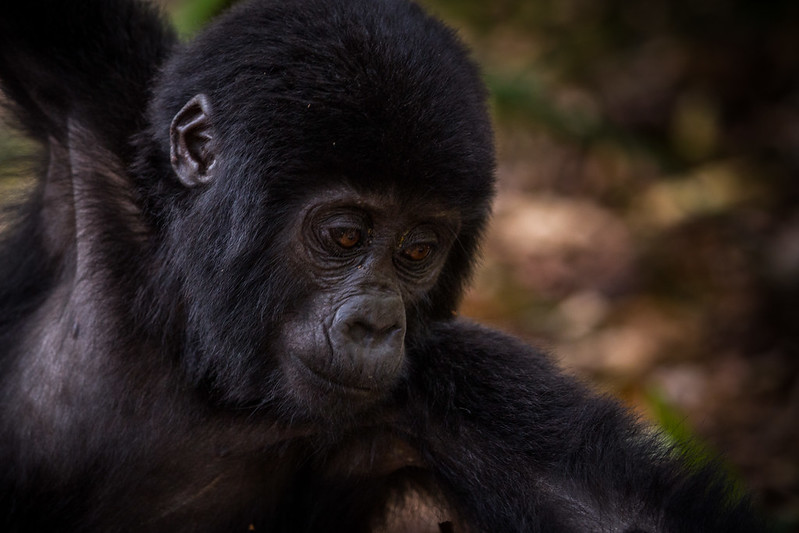
-
What Is The Packing List For Gorilla Trekking?
Whichever your gorilla trekking destination is (Democratic Republic of Congo, Rwanda or Uganda), there are some necessities that you must have with you for example;
Long Safari trousers
: Long trousers protect your legs from cuts and bruises from the high, lush, thick vegetation as well as thorns, and tree branches while gorilla trekking. They will protect you from rashes arising as allergic reactions to plants like nettles that are prevalent in Rwanda.
Long Safari style shirts or t-shirts:
The weather is very unstable and can change from extremely cool in high altitudes to extremely hot at low altitudes so you should wear comfortable clothing for both conditions.
A rain jacket or waterproof jacket
: This is one of the most important items to carry for gorilla trekking because the tropical areas where the mountain gorillas live are thriving and rain falls at anytime even during the dry season.
Hair bandana or hat:
These protect your hair from getting caught in tree branches or getting filled up with things that keep falling from the trees.
Waterproof hiking shoes
: Your hiking shoes should have a firm grip to prevent you from falling on the slippery trails and also as high as the ankle to keep you dry in case it rains or you step in a puddle or have to walk across a water pool or through mud.
Waterproof backpack:
It is essential for your back pack to be waterproof to keep your belongings dry in case it rains for example your camera, binoculars.
Insect repellent
: Rwanda and Uganda both have a variety of insect species therefore it is highly important for you to carry insect repellant to protect against insect bites as well as diseases such as malaria which is still widespread in these countries.
Other essentials include; Sunglasses with neck strap, thick gloves, bottled drinking water, sunscreen, Personal toiletries and tissues, and a camera with extra batteries.
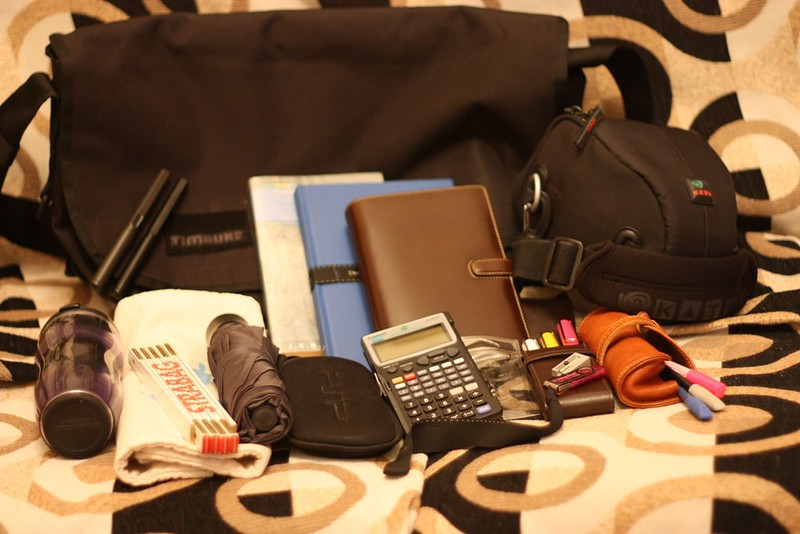
-
Why is Gorilla Trekking very expensive?
Many people have dreamed of taking a gorilla safari to either Uganda or Rwanda, however, because of the high overall cost of the tour, many people have unfortunately not been able to enjoy this amazing experience. The main contributing factor to this high cost is the price of a trekking permit. For instance, while trekkers in Rwanda pay $1500 USD their counterparts in Uganda part with $600 USD for their gorilla permits and below are the reasons for this high cost.
Conservation of Gorillas:
Firstly, the high prices are the only way to limit the number of trekkers at a time. Overcrowding gorillas in their natural habitat poses a threat to their conservation and to the vegetation cover because paths need to be cleared to make trails for the trekkers.
To control excessive familiarization of Gorillas with people:
excessive familiarization of gorillas to people is not good as it interferes with their natural being; remember gorillas are wild. The high gorilla cost have been implemented to reduce on human visitors
Development of the local community:
To add to this, Frontline communities also receive a portion of the funds from Gorilla tourism. Part of the proceeds from the gorilla permits is used for better service deliver to the frontline communities including: construction of roads, health centers, education and provision of clean piped water.
Payment of caretakers:
There is need to pay the team that monitors the Gorillas from dawn to dusk. This team includes doctors, rangers and security guards. If unguarded can be poached or fall in traps, and in addition monitoring them reduces the risk of contracting human diseases such as Ebola, tuberculosis, flu, cough and the like. These diseases can attack and cause death to gorillas.
Gorillas can only be seen from their natural habitat.
Adventure tourists meet the cost of seeing gorillas in their natural habitat because there is no other alternative of seeing the gorillas in perhaps a zoo unless in their natural habitats which are in Uganda, D.R Congo and Rwanda across the entire universe. It is because of this that the demand for permits is at a constant high from January to December, which forces trekkers to book their permits three months prior to their trekking date.
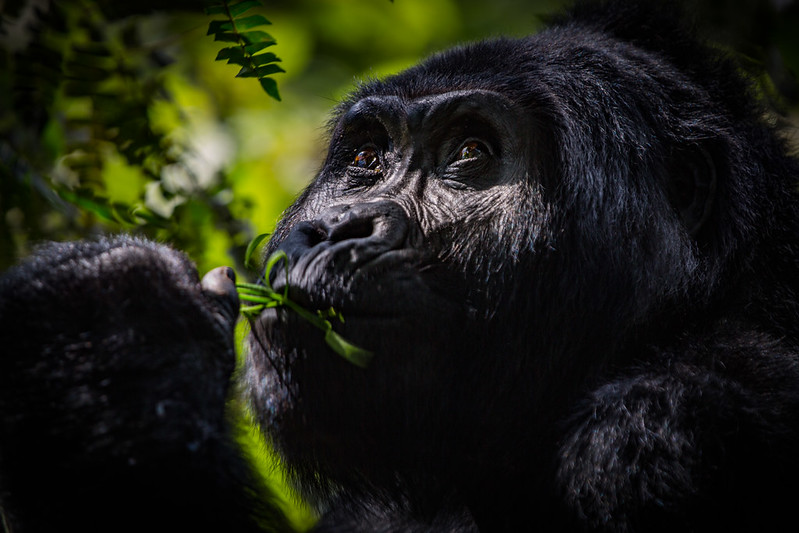
-
Is Gorilla Trekking Worth the Money?
Mountain gorilla trekking gives a very memorable wildlife experience. It is impossible for a trekker to forget a first time experience of seeing a gorilla emerge out of its habitat, with a whole troop following afterwards. The sight of the giant dominant silver back with its sheer size and characteristic silver hair on the back is very impressive. Trekking in Uganda’s Bwindi Impenetrable National Park is special because it inhabits half of the world’s mountain gorillas. However, holidaymakers can enjoy a gorillas trekking experience in Volcanoes national Park found in Rwanda,, or Mgahinga National Park in Uganda or the Virunga National Park in Congo.
The price of gorilla trekking is the highest among the safari activities on the African continent with Rwanda charging the highest amount at $1500 USD per person per trek, Uganda at $600 USD per person per trek and the D. R Congo with the lowest rates of $ 450 USD in the peak season and $200 USD in the low season.
What really makes this activity worthwhile is that fact that trekkers will get a chance to personally encounter these highly endangered species that share 98% of their DNA with man – which makes them the closest relatives to man. Now because these hairy giants do not stay in captivity such as the zoo, they can only be seen in their natural habitats within the verdant rainforest.
In the 19th Century, mountain gorillas were about 300 in number. Fortunately, this number has increased to nearly 1000 individuals today thanks to the efforts to conserve them. These efforts are financed by the money accumulated from gorilla tourism activities like trekking and habituation. Conservation efforts are important because they preserve this heritage so that they even the coming generations can enjoy seeing them. Therefore trekkers indirectly contribute to the preservation of the mountain gorillas.
In addition, mountain gorilla conservation greatly benefits the local communities living near the gorilla habitats. For instance, the Republic of Uganda allocates twenty percent (20%) of the proceeds acquired from gorilla tourism to the frontline communities whereas the Republic of Rwanda allocates ten percent (10%). as a result this has increased awareness of the importance of gorilla conservation among the locals who would may be have poached this critically endangered species.
Therefore, seeing gorillas in their natural habitat is very worthwhile and it’s an activity I would recommend for any holidaymaker hoping to visit Africa as it will reward you with unforgettable and wildlife experience you have ever imagined.
-
Are Their Gorillas in South Africa, Kenya or Tanzania?
There are no gorillas in South Africa or Kenya and Tanzania. You can only find gorillas in Uganda, Rwanda and Congo. If you would like to combine African safaris targeting wildlife in those countries and then the gorillas of East Africa, that is possible given the number of connecting flights available in the region. The most prominent safari is that of Masai Mara Safari with the Gorillas of Rwanda and Uganda. With Tanzania, you can spend time on the migration of the wildebeest safari and then cross to Uganda for gorilla trekking adventure in bwindi.

